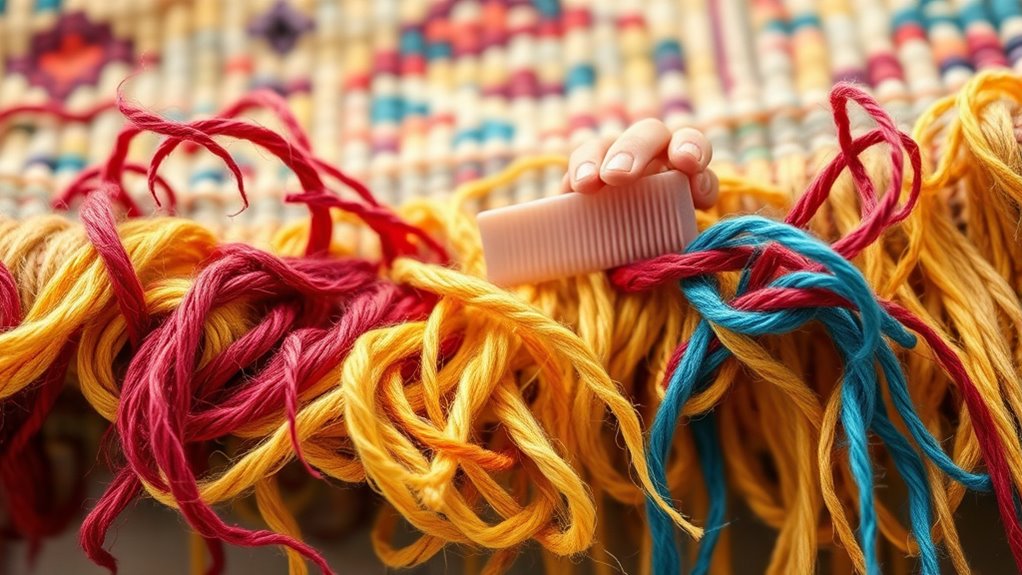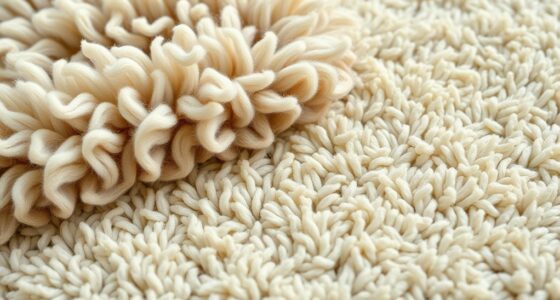To detangle your rug fringe, start by carefully evaluating its condition and gathering the right tools like scissors, a fine-tooth comb, and gentle detangling solutions. Gently loosen knots with your fingers or a brush, then trim frayed ends safely to prevent further unraveling. Reinforce weak spots with sewing or patches. Maintaining your fringe regularly keeps it tidy. If you want detailed steps to restore your rug’s fringe effectively, there’s more to discover below.
Key Takeaways
- Assess fringe damage, tangles, and stains before beginning, and gently straighten fibers with fingers or a wide-tooth comb.
- Use detangling solutions like conditioner or spray to soften fibers and loosen knots for easier handling.
- Carefully trim frayed threads and remove debris with sharp scissors and a soft brush or vacuum attachment.
- Gently untangle knots starting from the ends, working inward with your fingers, tweezers, or a fine-tooth comb.
- Trim uneven or frayed edges precisely, then reinforce weak areas with matching thread or patches to prevent further unraveling.
Assessing the Condition of Your Rug Fringe
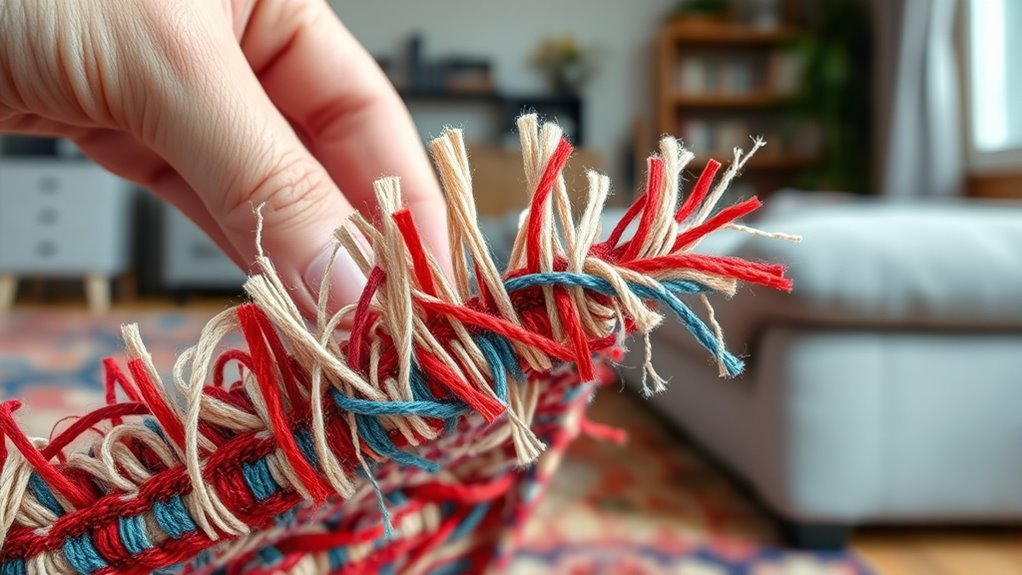
Before you begin any repair or cleaning, it’s important to assess the condition of your rug fringe carefully. Examine the fringe closely for signs of damage, such as fraying, unraveling, or broken threads. Check if the fringe is tangled or matted, which can make cleaning or detangling more difficult. Look for areas where the fibers are worn down or thinning, indicating excessive wear. Take note of any stains, dirt buildup, or discoloration. Determine whether the fringe is tightly attached or loose, as loose fringes might need reinforcement. This assessment helps you understand the extent of work needed and prevents accidental damage during the cleaning process. Being thorough now guarantees you approach the task with a clear plan and avoid worsening existing issues. Additionally, understanding automation in business can inspire innovative solutions for maintaining your rugs efficiently.
Gathering the Right Tools and Supplies
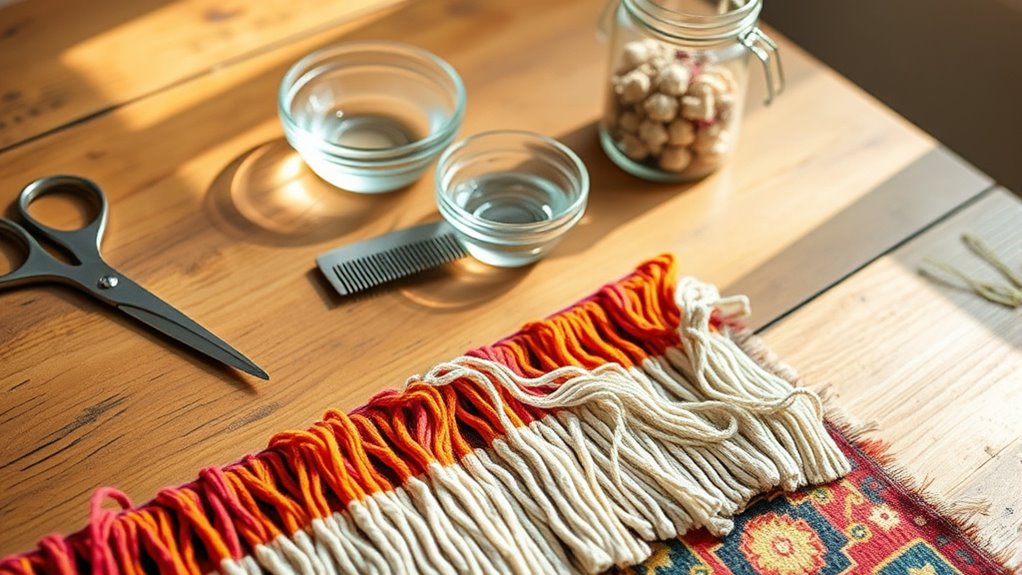
Before you start, make sure you have all the essential tools and supplies ready. This includes items like scissors, a ruler, and strong thread, along with any other materials specific to your rug. Having everything on hand will help you work smoothly and efficiently. Additionally, understanding the types of cookies used on websites can help you manage your online privacy while researching or shopping for supplies.
Essential Tools List
To create a professional-looking rug fringe, you’ll need a few essential tools and supplies. First, grab a pair of sharp scissors to trim frayed or tangled fibers neatly. A fine-tooth comb or a small detangling brush helps gently separate tangled strands without causing damage. You’ll also want a pair of sturdy tweezers for precise work on stubborn knots. Have a clean work surface to prevent further tangling. If you plan to reattach or secure loose fibers, consider using fabric glue or a needle and thread. Finally, keep a bottle of gentle conditioner or detangling spray nearby to soften fibers, making them easier to work through. Using color correction techniques can also help restore the appearance of your rug fringe if discoloration occurs. With these tools, you’re well-equipped to restore your rug fringe efficiently and professionally.
Necessary Supplies Checklist
Gathering the right tools and supplies is essential for creating a clean, professional-looking rug fringe. Start with sharp scissors or a rotary cutter to trim uneven or frayed edges precisely. You’ll also need a fine-tooth comb or a detangling brush to gently work through tangled fibers without causing damage. Having some fabric or craft glue on hand can help secure loose threads or reinforce the fringe if needed. A pair of tweezers can assist in removing stubborn knots, and a clean cloth or towel helps keep the area tidy. Don’t forget to wear protective gloves if you’re handling adhesives or working with sharp tools. Collecting these supplies beforehand ensures a smooth, efficient process, giving your rug a refreshed, polished look. Additionally, understanding the importance of proper appetizer selection can inspire creative ideas for home entertaining.
Removing Loose Threads and Debris
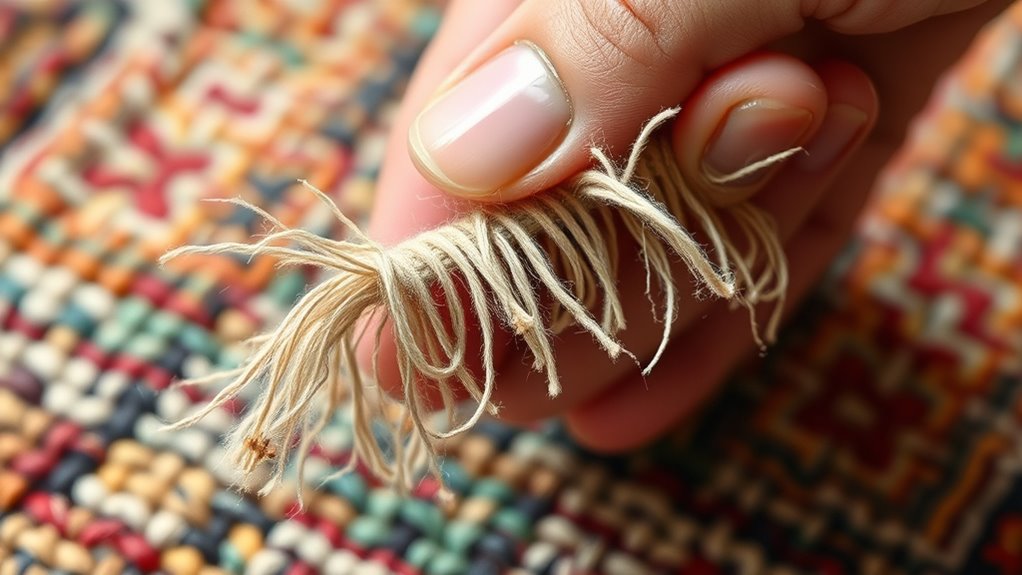
Loose threads and debris can quickly detract from your rug’s appearance, so it’s important to address them promptly. Begin by inspecting the fringe carefully to identify loose threads or small bits of debris like dust or lint. Use a pair of scissors to trim any frayed or hanging threads, cutting close to the base without pulling on the fibers. For debris, gently shake the fringe or use a soft brush to loosen dirt and dust. You can also use a vacuum with a brush attachment on a low setting to remove loose particles. Avoid pulling on loose threads, as this can cause further unraveling. Regularly checking and cleaning your fringe helps maintain its neat appearance and prevents small issues from worsening. Incorporating professional equipment and techniques can further improve your results.
Gently Untangling Small Knots by Hand
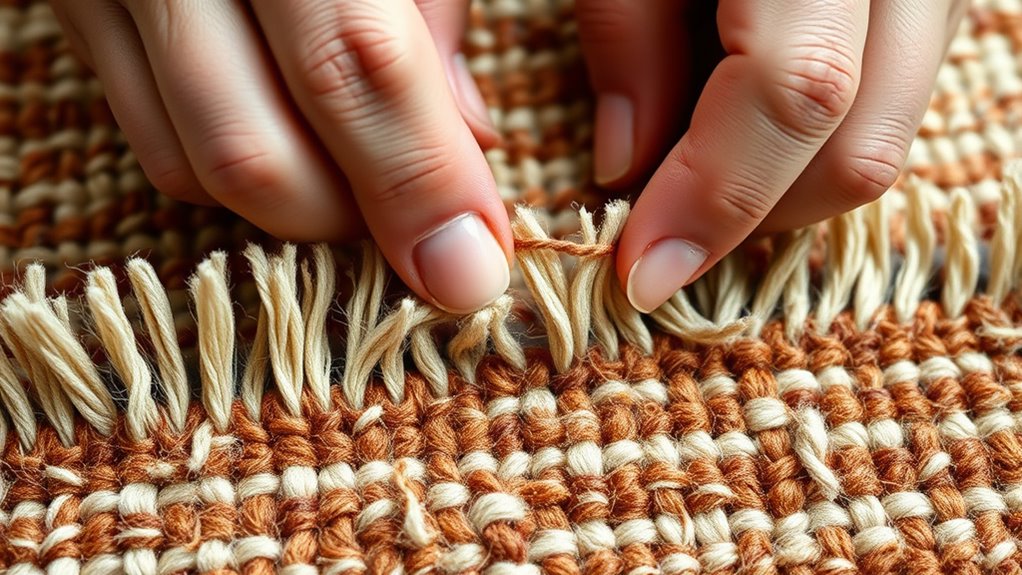
When untangling small knots in your rug fringe, use a gentle grip to avoid damaging the fibers. Start working from the ends of the knots and carefully loosen them inch by inch. Remember, patience is key—rushing can make the knots worse. Using a gentle touch can help prevent fiber damage during the process.
Use Gentle Grip
To gently untangle small knots in your rug fringe, use a light grip and patience. Grasp the fringe fibers softly without pulling or tugging aggressively. Applying gentle pressure helps prevent additional knotting or fraying. As you work, focus on loosening each knot carefully rather than rushing to untangle everything at once. If a fiber resists, don’t force it; instead, try slightly adjusting your grip or using your fingertips to tease apart the strands. Keep in mind that a firm grip can tighten knots or cause damage. Patience is key—slow, deliberate movements allow you to gently loosen knots without harming your rug’s fibers. Remember, the goal is to preserve the integrity of the fringe while removing tangles effectively. Using a gentle grip reduces the risk of damaging delicate fibers during the process.
Work From Ends
Have you considered starting from the very ends of your rug fringe to untangle small knots? Working from the tips inward allows you to gently loosen knots without pulling or damaging the fibers. Use your fingers to carefully tease apart each knot, moving slowly to avoid tightening the tangle. If needed, employ a small tool like tweezers for precision. Focus on small sections at a time, and avoid forceful pulls. To stay organized, keep track of the knots you’ve addressed with this table:
| Knot Size | Technique |
|---|---|
| Small | Gentle finger teasing |
| Medium | Use tweezers carefully |
| Large | Patience, work in sections |
This approach keeps your fringe intact and neat, preventing further tangling. Practicing gentle handling helps protect the delicate fibers and maintains the overall appearance of your rug.
Patience Is Key
Patience is essential when gently untangling small knots in your rug fringe, as rushing can tighten the tangle or cause fiber damage. Take your time, working slowly and carefully to avoid pulling too hard. Use your fingers or a small, pointed tool to gently loosen the knot, applying light pressure to prevent fraying. If the knot doesn’t come apart easily, step back and give it a few minutes before trying again. Rushing might make the tangle worse or damage the delicate fibers. Remember, patience helps you maintain control and ensures your fringe stays intact. With a calm approach, you’ll find the knots come undone more smoothly, preserving the beauty and integrity of your rug fringe. Sound vibrations are also believed to help relax tense fibers during the process.
Using a Comb or Brush for Frayed Ends

Ever wonder how to tame frayed rug edges effortlessly? Using a comb or brush can make a big difference. Gently start at the end of the frayed fibers and work your way back, carefully lifting and detangling any knots. Choose a fine-tooth comb or a soft-bristle brush to avoid damaging the fibers. Be patient and gentle—rushing can cause more fraying or pull out fibers you want to keep. As you comb through, straighten and align the loose strands. This method helps smooth out the edges, making your rug look neater and preventing further fraying. Remember, gentle strokes are key to avoiding damage while effectively managing those unruly fibers. Additionally, understanding fiber types can help you choose the best tools for your specific rug material.
Applying a Detangling Solution or Conditioner

Applying a detangling solution or conditioner can considerably ease the process of smoothing out frayed rug edges. Start by lightly spraying or applying the product directly onto the frayed fibers. Let it sit for a few minutes to loosen the knots and soften the fibers. This makes it easier to work through tangles without causing further damage. Use your fingers or a wide-tooth comb to gently work through the area, starting from the tip and moving towards the base. Avoid pulling or tugging too hard, which could worsen fraying. The conditioner or solution will help lubricate the fibers, reducing resistance and making detangling smoother. Repeat the process if necessary, ensuring the fibers become more manageable before proceeding to trim or further repair.
Trimming Excess Fraying Safely
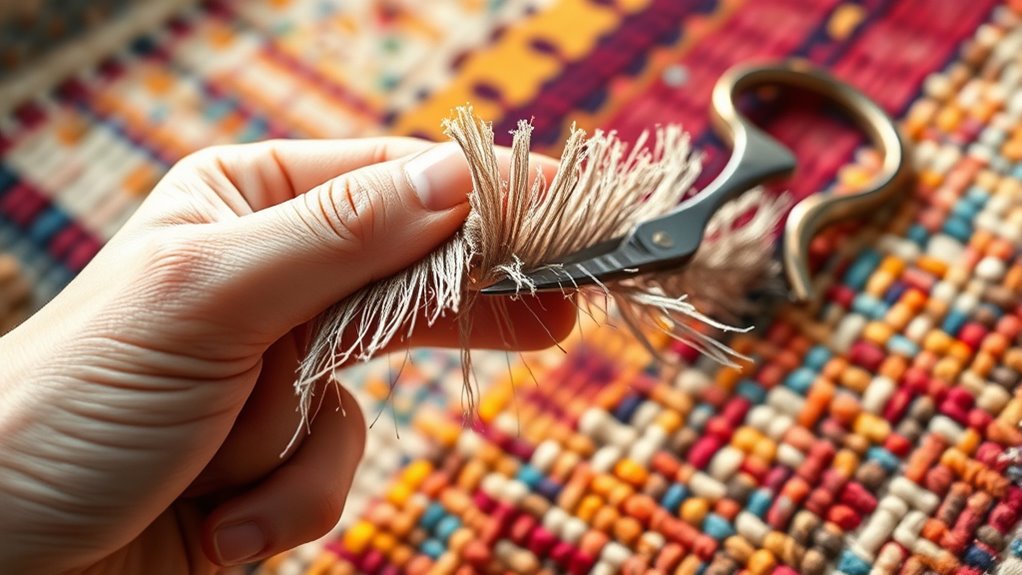
To trim excess fraying safely, you need the right tools like sharp scissors or a rotary cutter. Make sure you follow proper techniques, such as cutting in small sections and keeping your fingers clear. Using the correct tools and methods helps prevent accidents and gives your rug a clean, professional look.
Select Proper Tools
Choosing the right tools is essential for trimming your rug fringe safely and effectively. Use sharp scissors or fabric shears designed for precision cutting. Dull blades can snag fibers or cause uneven edges, so make sure your scissors are sharp and in good condition. A seam ripper or small utility knife can also work for detailed trimming, but handle them carefully to avoid damaging the rug. Avoid using dull or household scissors, as they increase the risk of uneven cuts and fraying. Keep your tools clean and dry to prevent dirt or rust from contaminating the fibers. If your fringe is thick or tightly woven, consider using a rotary cutter with a cutting mat for cleaner, more controlled cuts. Proper tools make your trimming safer and result in a neater finish.
Follow Safe Techniques
When trimming your rug fringe, it’s crucial to work carefully to avoid damaging the fibers or creating uneven edges. Use sharp scissors and trim gradually, checking your work frequently. Keep the fringe even by measuring sections before cutting. Always cut straight across, avoiding jagged edges that could unravel. If you’re unsure, trim less at first and adjust later. To prevent accidents, secure the rug or work on a flat surface. Remember, patience is key to a professional-looking finish. Here’s a quick guide to keep you safe:
| Step | Tip | Caution |
|---|---|---|
| Use sharp scissors | Clean blades for smooth cuts | Avoid dull blades |
| Measure carefully | Use a ruler for straight lines | Don’t guess measurements |
| Cut gradually | Small snips at a time | Don’t rush |
| Secure rug | Flat surface or tape | Prevent slipping |
| Check frequently | Step back to review | Over-trimming risks |
Reinforcing Weak or Thinning Fringe Areas
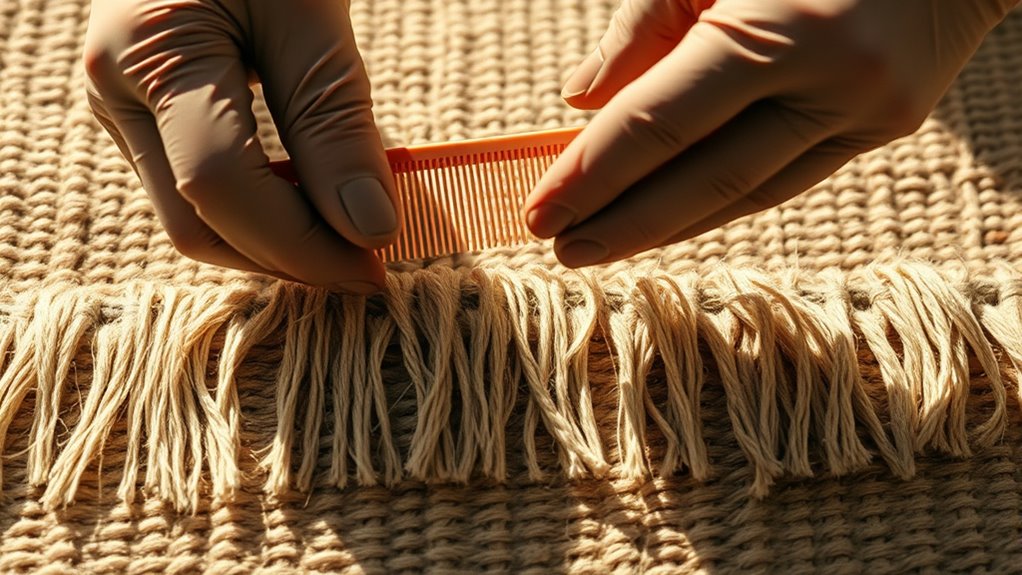
If you notice areas of your rug fringe that are weak or thinning, it’s important to reinforce them promptly to prevent further damage. Start by gently securing loose or frayed threads with a needle and matching thread. Avoid pulling on the fringe, as this can worsen the damage. Instead, carefully sew along the weak spots, stitching close to the base of the fringe to strengthen the fibers. For areas with significant thinning, consider adding a small patch of similar material underneath and stitching it in place for extra support. Be sure to keep your stitches tight but unobtrusive, so the reinforcement blends seamlessly. Reinforcing early helps maintain your rug’s appearance and prevents fraying from spreading further.
Preventative Tips to Maintain Your Rug Fringe
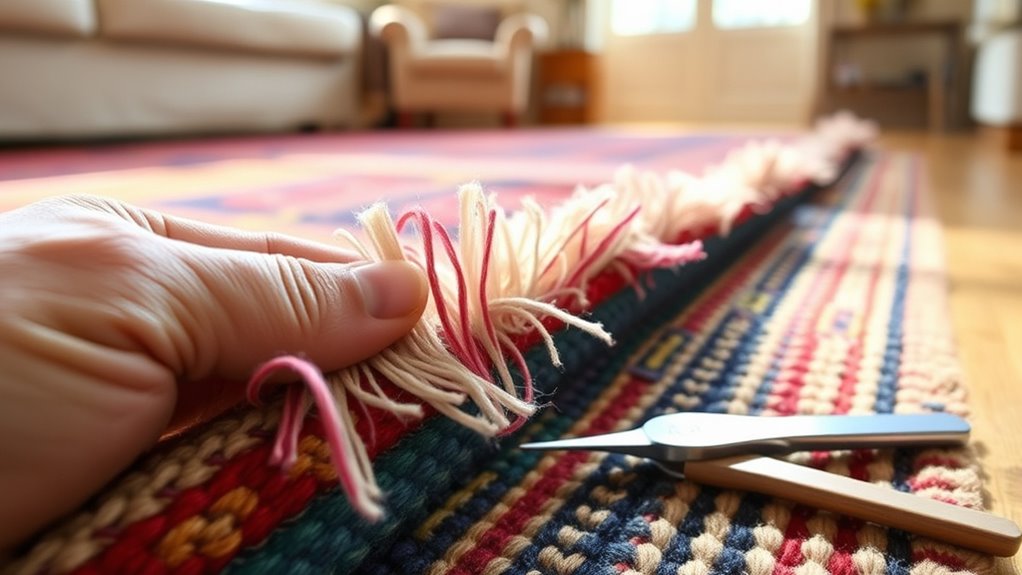
Regular maintenance can help keep your rug fringe looking neat and prevent damage before it starts. Start by gently shaking or vacuuming the fringe regularly to remove dust and loose fibers. Avoid pulling or tugging on the fringe, which can cause fraying. To further protect it, consider placing a rug pad underneath to reduce friction. Keep the fringe dry and avoid exposing it to excessive moisture or direct sunlight, which can weaken fibers. Here’s a quick overview:
| Tip | Why it helps | Best practice |
|---|---|---|
| Regular vacuuming | Removes dirt and prevents tangles | Use a gentle brush attachment |
| Avoid pulling | Prevents fraying and tearing | Handle with care during cleaning |
| Use a rug pad | Reduces friction and wear | Choose a supportive, non-slip pad |
When to Seek Professional Help
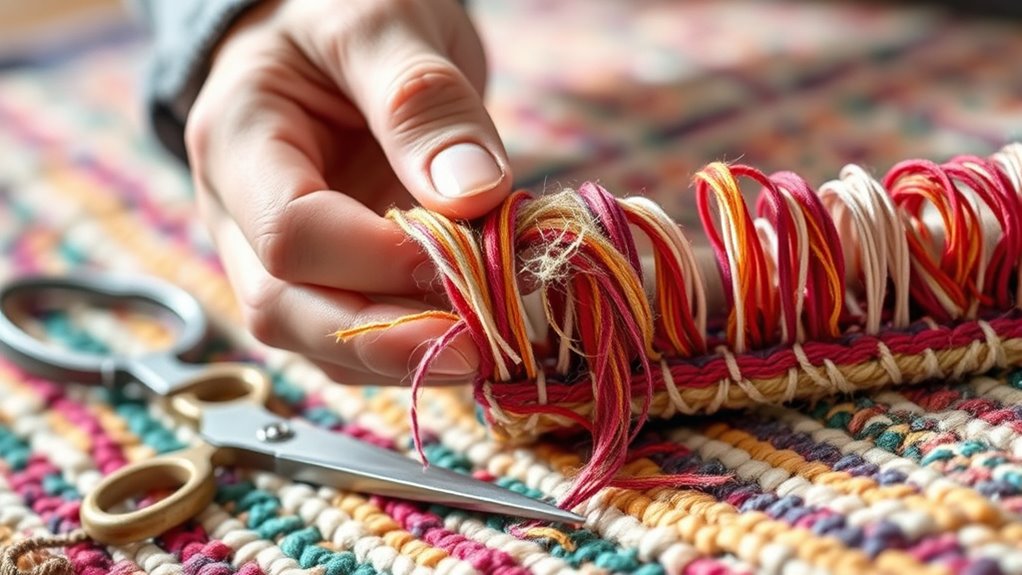
Even with careful maintenance, some issues with your rug fringe require professional attention. If you notice severe fraying, unraveling, or large sections of tangled fibers, it’s time to seek expert help. Attempting to fix extensive damage yourself can sometimes worsen the problem or cause further unraveling. Additionally, if your fringe has been stained or heavily soiled, professionals can clean and restore it properly without risking damage. If you’re unsure about the extent of the damage or lack the necessary tools, consulting a rug specialist ensures the fringe is repaired correctly and preserved for years to come. Don’t hesitate to contact a professional when your DIY efforts aren’t enough—proper care now can save you money and frustration later.
Frequently Asked Questions
How Often Should I Detangle My Rug Fringe to Prevent Damage?
You should detangle your rug fringe regularly to keep it looking neat and prevent damage. Aim for once every few weeks, or whenever you notice tangles or knots forming. Gently brushing or using your fingers helps loosen knots without pulling or tearing fibers. Consistent maintenance prevents major tangles and keeps your rug’s fringe in good condition, making it easier to care for over time.
Can I Use Household Products as a Detangling Solution?
Think of your rug fringe like delicate hair—you wouldn’t use harsh chemicals on your scalp. Household products often contain ingredients that can weaken fibers or cause discoloration, so it’s best to avoid them. Instead, use a gentle solution like mild dish soap mixed with water. I once used vinegar for a stubborn tangle, and it worked beautifully without damage. Keep it simple and safe for the best results.
What Are Signs That My Fringe Needs Professional Repair?
You’ll notice your fringe needs professional repair if it’s severely frayed, tangled beyond simple detangling, or if the fibers are pulling away from the rug. If your attempts to untangle cause more damage or if the fringe looks uneven or heavily worn, it’s time to seek expert help. Ignoring these signs can lead to further deterioration, so don’t hesitate to get professional repair to keep your rug looking its best.
Is It Safe to Wash My Rug Fringe Regularly?
You might wonder if washing your rug fringe regularly is safe. While gentle hand washing with mild detergent can keep your fringe clean, overdoing it can cause damage or fraying. Think of your fringe like delicate hair—it needs care, not frequent washing. Always check the rug’s label and avoid harsh chemicals. Regular light cleaning is fine, but deep washing should be reserved for professional cleaning to protect your fringe’s integrity.
How Do I Prevent Future Tangling of Fringe During Cleaning?
To prevent future tangling of your rug fringe during cleaning, you should regularly brush it with a gentle, wide-tooth comb or a soft-bristled brush. Avoid harsh scrubbing or pulling, and always clean in the direction of the fringe’s fibers. When washing, secure the fringe gently to prevent movement, and consider using a mesh bag or pillowcase. Taking these precautions keeps your fringe neat and tangle-free over time.
Conclusion
Think of your rug’s fringe as the shimmering edge of a treasured story. With gentle care, you preserve its delicate threads, allowing your home’s narrative to continue flowing smoothly. By tending to each knot and unraveling each tangle, you keep the story vibrant and alive. Remember, a well-maintained fringe isn’t just decoration—it’s a symbol of love and attention woven into your space, shimmering like a beacon of warmth and care.
